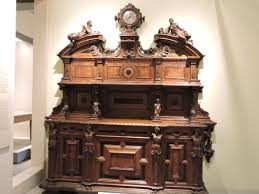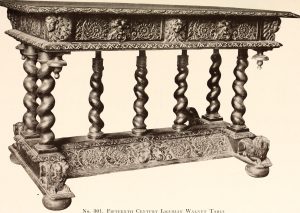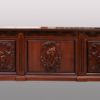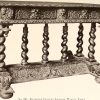Antique furniture has incredible value, especially when it is a well-made, constructed piece. Prior to the 1860s, furniture was handcrafted individually by skilled craftsmen. Each furniture piece was distinct, a mark of pride and skill.
 Since then, however, mass producing furniture became increasingly feasible, cost-effective and, as a result, the norm. Still, if you’re on the prowl for valuable antique furnishings, you can spot them with some determination. It takes abundant research to become an expert on the market, plus plenty of experience to recognize what kinds of furniture are on the brink of becoming valuable objects of a collector’s fancy.
Since then, however, mass producing furniture became increasingly feasible, cost-effective and, as a result, the norm. Still, if you’re on the prowl for valuable antique furnishings, you can spot them with some determination. It takes abundant research to become an expert on the market, plus plenty of experience to recognize what kinds of furniture are on the brink of becoming valuable objects of a collector’s fancy.
In antique showrooms in the United States, you’re likely to find mostly American and English furniture. It’s unlikely you’ll run across a mid-15th century couch once used prolifically by a French royal, for instance. English and American styles, in all their hardiness, can be incredibly varied, from dainty to sturdy or from functional to purely decorative.
Start with identifying the three things that make an antique furniture piece valuable. History, condition and rarity are three important aspects that make or break the value of a piece.
History – Fine antique dealers place pieces that are over 150 years old in the antique category.
Condition – Any damage to an antique may affect its value. However, pieces can be professionally restored. A reputable furniture restorer can tell you accurately if the piece can be restored or if it is beyond repair. Plus, the patina, or accumulated dirt on the piece, can influence its value. Depending on the piece, an antique furniture item may increase in value if it has evidence of significant patina as opposed to a piece that is immaculate in condition.
Rarity – Even some genuine reproductions of antique furniture pieces, such as those from the 1500s or 1600s, can be enormously valuable.
Recognize a fake. Consult an expert in antique trades when you stumble upon an item that may be either undervalued or an imitation. A novice’s perception is largely undeveloped compared to an expert’s. Stay up to date on scams within the antique trade industry. You can find plenty of information in reputable antique trade publications.
The approximate date of furniture pieces can be gauged by examining the joinery. Handcrafted furniture shows few and uneven dovetailed joints. Machine-cut pieces can be identified by the precisely-cut dovetails. Handmade furniture pieces suggest they were created prior to 1860.
Another identifying marker that signals an antique furniture piece is located on the bottom, sides or back. Circular marks indicated the piece was manufactured with a circular saw, a tool that was not in use until approximately 1860. In contrast, a piece of furniture displaying nicks and cuts is likely to have been cut using hand tools, like a drawknife or plane. Similarly, old pieces are identifiable by the presence of saw marks.
Imperfection abounds in handcrafted, antique furniture. Small components, like spindles, rockers or rungs are rarely uniform in antique pieces. Perfectly symmetrical furniture pieces were produced by a machine—signaling a more recent production date.
When examining furniture at a dealer’s showroom, pay close attention to the furniture’s finish. Lacquer and varnish were developed after 1860, indicating a newer piece. However, shellac is commonly found on dated pieces, like those prior to 1860. Very old furniture may also have been finished with oil, wax, milk paint or were perhaps French-polished.
 The type of wood used in furniture pieces is a probable sign that you’re looking at an antique. Oak wood was primarily used to construct furniture from the Middle Ages until the start of the 18th century. A few hundred years prior to the 18th century, walnut and mahogany started to be favored by furniture craftsmen. English and American furniture pieces were largely made with mahogany wood since the mid-1700s until the next century, after being imported from the British colonies and introduced to England.
The type of wood used in furniture pieces is a probable sign that you’re looking at an antique. Oak wood was primarily used to construct furniture from the Middle Ages until the start of the 18th century. A few hundred years prior to the 18th century, walnut and mahogany started to be favored by furniture craftsmen. English and American furniture pieces were largely made with mahogany wood since the mid-1700s until the next century, after being imported from the British colonies and introduced to England.
Don’t be fooled by hardware. Drawer pulls, for instance, may have been replaced over the years. Look beyond the hardware to the true value of the piece itself.
Research the antique market to identify pieces that are gaining in popularity rather than those that are already at the peak of appeal. This approach works well when it comes to purchasing the furniture at competitive prices.
A piece can explode in value when it is made by a particular craftsman. To gain the advantage, it is highly beneficial to be aware of popular furniture craftsmen of each period. When you take a look at a furniture piece, note any maker’s marks—stamps into the furniture or paper labels attached to the underside.
The style of furniture can, on some occasions, indicate when it was created. You can get a good grip on the time by becoming familiar with furniture legs. Experts note that thin, fluted legs evolved in the 1750s to 1850s. Since then, styles have differed and even some were created outside this timeframe. Style is a good indicator, however it is not 100 percent accurate.
When you stumble upon an antique piece of furniture and conclude that its restoration would deem it to be significantly more valuable, then your best bet is to contact an antique furniture restorer. Furniture Medic by Bob Llorente is a reputable furniture restorer experienced in restoring both valuable antiques and family heirlooms. The skilled restorers at Furniture Medic by Bob Llorente perform careful work on antiques to preserve the original character and workmanship of every piece in their care. As a result, the piece retains its value and status as an antique.












